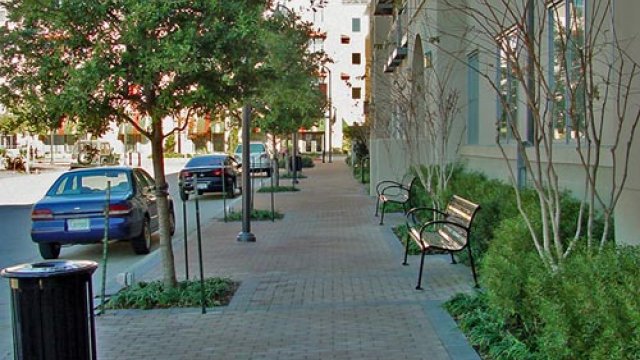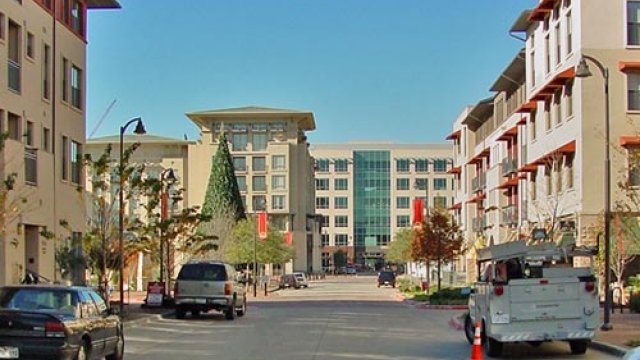Mix Land Uses: Legacy Town Center, Plano, Texas
Legacy Town Center in Plano, Texas, created mixed-use infill by building a town center in an existing office park.
Electronic Data Systems (EDS) sought to attract employees by creating a town center near its office where workers can live, shop, eat, relax, and run errands. Many of these employees work around the clock and appreciate the convenience of the town center. Hewlett Packard's telecommunications business unit chose Legacy Town Center for its new headquarters because its location and design are convenient for employees while still making good business sense.
Mixing uses at Legacy Town Center also makes good environmental sense. National studies show that people who work in locations that provide a wide range of services within walking distance are more likely to consider carpooling, vanpooling, and public transit.1
Most workers drive to and from work daily and also use their cars at lunch. A study done before the town center's completion showed that half the workers would leave the office park at lunch, driving between 2 and 5 miles. Legacy's mixed-use town center gives workers options for getting to work and running errands, reducing congestion and pollution during rush hours.
The town center has homes, stores, offices, restaurants, lodging, and entertainment on 150 acres, all within a 10-minute walk of one another. As in a traditional town center, Legacy's buildings are near the street, with sidewalks in front and parking around the sides and in back. This design encourages workers and residents to walk to daily errands and allows visitors to park once and enjoy the area on foot.
Developers Post Properties and Amicus Partners built 2,700 apartments in mixed-use buildings, and K. Hovanian built town homes, offering alternatives to the single-family homes and garden apartments typical of Plano's housing. Leddy Company and Karahan Companies built the town center's lodging and retail. In addition to the town center's amenities, residents can enjoy 5 acres of public parks and a 4-acre lake.
This case study was first published in 2006 and updated in March 2012.
Find other case studies in Smart Growth Illustrated that discuss the 10 smart growth principles.
1. Cambridge Systematics. 1994. The Effects of Land Use and Travel Demand Strategies on Commuting Behavior. Washington, DC: U.S. Department of Transportation, Federal Highway Administration.
-

Employees at EDS headquarters can walk to the town center to eat and run errands. The apartment building on the left offers housing for employees who want to live near where they work. Photo courtesy of EDS Real Estate.
-

Apartment buildings and a hotel in Legacy Town Center. The hotel allows business travelers to be close to their clients in the offices. Photo courtesy of EDS Real Estate.
-

Wide sidewalks, attractive paving materials, on-street parking, street trees, and street furniture combine to create a pleasant walking experience in the town center. Photo courtesy of EDS Real Estate.
-

Stores under construction at the town center gateway. Many apartment buildings, like the one in the center of this photo, have first-floor shops. Photo courtesy of EDS Real Estate.
